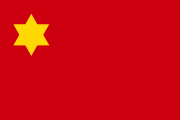Xinjiang People's Anti-Imperialist Association 新疆民眾反帝聯合會 | |
|---|---|
 | |
| President | Sheng Shicai |
| Founder | Sheng Shicai |
| Founded | 1 August 1935 |
| Dissolved | April 1942 |
| Headquarters | Ürümqi, Xinjiang |
| Newspaper | Anti-Imperialist War Front |
| Youth wing | Xinjiang's Youth |
| Women's wing | Xinjiang's Women |
| Membership (1939) | 10,000 |
| Ideology | |
| Party flag | |
 | |
| Xinjiang People's Anti-Imperialist Association | |||||||||
|---|---|---|---|---|---|---|---|---|---|
| Traditional Chinese | 新疆民眾反帝聯合會 | ||||||||
| Simplified Chinese | 新疆民众反帝联合会 | ||||||||
| |||||||||
The Xinjiang People's Anti-Imperialist Association[a] (Chinese: 新疆民眾反帝聯合會; pinyin: Xīnjiāng Mínzhòng Fǎn Dì Liánhé Huì) was a political party in Xinjiang, China, during the rule of Sheng Shicai from 1935 to 1942.
History[edit]
The People's Anti-Imperialist Association was founded by Sheng Shicai in Ürümqi on 1 August 1935. The propaganda outlet of the Association was the Anti-Imperialist War Front. The Sinkiang's Youth and the Sinkiang's Women served as the Association's youth and women's wing, respectively. The Association saw a large increase in membership. In 1935 it had 2,489 members, in 1937 the membership grew to 5,281, and in 1939 the Association's membership rose to 10,000.[4] The membership was nationally diverse, and included Han, Hui and various Turkic peoples.[5]
The ideology of the People's Anti-Imperialist Association was the "Six Great Policies", issued by Sheng in December 1934.[6] The policies guaranteed his previously enacted "Great Eight-Point Manifesto".[7] They included "anti-imperialism, friendship with the Soviet Union, racial and national equality, clean government, peace and reconstruction".[6][7] Sheng referred to them as "a skilful, vital application of Marxism, Leninism, and Stalinism in the conditions of the feudal society of economically and culturally backward Sinkiang".[8] They served as the ideological basis of Sheng's rule.[9] With the proclamation of the Six Great Policies, Sheng adopted a new flag with a six-pointed star to represent these policies.[10]
With Sheng's rapprochement with the Central government, the Kuomintang spread throughout the province, replacing the People's Anti-Imperialist Association,[11] which was disbanded in April 1942.[12]
Notes[edit]
Footnotes[edit]
- ^ Rahman 2005, p. 38.
- ^ Chaudhuri 2016, p. 59.
- ^ Brophy 2016, p. 256.
- ^ Chan 1983, p. 378.
- ^ De Cordier 2016, p. 61.
- ^ a b Clarke 2011, p. 33.
- ^ a b Mansfield 1945, p. 3735.
- ^ Sheng 1939.
- ^ Chan 1983, p. 377.
- ^ Brophy 2016, p. 255.
- ^ Jacobs 2011, p. 350.
- ^ Dallin 1948, p. 362.
References[edit]
Books[edit]
- Brophy, David (2016). Uyghur Nation. Cambridge, MA: Harvard University Press. ISBN 9780674660373.
- Chaudhuri, Debasish (2016). "China's Policy in Xinjiang, 1948–78". In Warikoo, K. (ed.). Xinjiang – China's Northwest Frontier. Abingdon-on-Thames: Routledge. ISBN 9781317290292.
- Clarke, Michael E. (2011). Xinjiang and China's Rise in Central Asia – A History. Abingdon-on-Thames: Taylor & Francis. ISBN 9781136827068.
- Dallin, David J. (1948). Soviet Russia and the Far East. New Haven, CT: Yale University Press. ISBN 978-0208009968.
- Jacobs, Justin Matthew (2011). Empire besieged: the preservation of Chinese rule in Xinjiang, 1884–1971. San Diego, CA: University of California, San Diego. ISBN 9781124814070.
- Mansfield, Mike (1945). "Outer Mongolia and Sinkiang". Congressional Record: Proceedings and Debates of the 79th Congress First Session. Vol. 91. Washington D. C.: U.S. Government Printing Office.
- Rahman, Anwar (2005). Sinicization Beyond the Great Wall: China's Xinjiang Uighur Autonomous Region. Kibworth Beauchamp: Troubador Publishing Ltd. ISBN 9781904744887.
Journals[edit]
- Chan, F. Gilbert (1983). "Sheng Shih-ts'ai's reform programs in Sinkiang: idealism or opportunism?". Journal of Modern History. 12: 365–385.
- De Cordier, Bruno (2016). "International aid, frontier securitization and social engineering: Soviet-Xinjiang development cooperation during the Governorate of Sheng Shicai (1933–44)". Central Asian Affairs. 3: 49–76. doi:10.1163/22142290-00301003. hdl:1854/LU-7043477.
- Nyman, Lars-Erik (1991). "Sinkiang 1934–1943: Dark decade for a pivotal puppet". Cahiers du Monde Russe. 32: 97–105. doi:10.3406/cmr.1991.2265.
Websites[edit]
- Sheng, Shicai (1939). "Translation of a 4 January 1939 Letter of Governor Sheng Shicai to Cdes. Stalin, Molotov, and Voroshilov". Woodrow Wilson International Center for Scholars. Retrieved 24 November 2017.
Well, that’s interesting to know that Psilotum nudum are known as whisk ferns. Psilotum nudum is the commoner species of the two. While the P. flaccidum is a rare species and is found in the tropical islands. Both the species are usually epiphytic in habit and grow upon tree ferns. These species may also be terrestrial and grow in humus or in the crevices of the rocks.
View the detailed Guide of Psilotum nudum: Detailed Study Of Psilotum Nudum (Whisk Fern), Classification, Anatomy, Reproduction